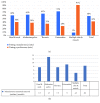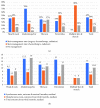Esophageal Cancer Metastases to Unexpected Sites: A Systematic Review
- PMID: 28659974
- PMCID: PMC5474273
- DOI: 10.1155/2017/1657310
Esophageal Cancer Metastases to Unexpected Sites: A Systematic Review
Abstract
The most common pattern of esophageal cancer metastases (ECM) is to the lymph nodes, lung, liver, bones, adrenal glands, and brain. On the other hand, unexpected metastasis (UM) spread to uncommon sites has increasingly reported and consequently affected the pathway of diagnosis, staging, and management. Using the PubMed database, a systematic search of the following headings "Esophageal" and "Metastasis" or "Metastases" was performed, 10049 articles were identified, and the articles were included if they demonstrated unexpected ECM. 84% of cases were men with an average age of 60.7 years. EC was located in the lower third in 65%. Two-thirds of the UM originated from the lower esophagus, and the two major histological types were adenocarcinoma 40% and squamous cell carcinoma 60%. Metastases were disseminated toward five main anatomical sites: the head and neck (42%), thoracic (17%), abdomen and pelvis (25%), extremities (9%), and multiple skin and muscle metastases (7%). The EC metastases were found to be synchronous 42% and metachronous 58%, isolated in 53.5% and multiple in 46.5%. The overall survival rate was 10.2 months. Since distant metastases are responsible for most EC-related deaths, understanding of ECM dissemination patterns needs more extensive studies. These critical data are the cornerstone of optimal cancer approach and treatment.
Figures









References
-
- American Cancer Society. Cancer Statistics Center. 2017, https://cancerstatisticscenter.cancer.org.
-
- Schlottmann F., Barbetta A., Mungo B., Lidor A. O., Molena D. Identification of the lymphatic drainage pattern of esophageal cancer with near-infrared fluorescent imaging. Journal of Laparoendoscopic & Advanced Surgical Techniques. Part a. 2016;27(3):268–271. doi: 10.1089/lap.2016.0523. - DOI - PMC - PubMed
Publication types
LinkOut - more resources
Full Text Sources
Other Literature Sources

